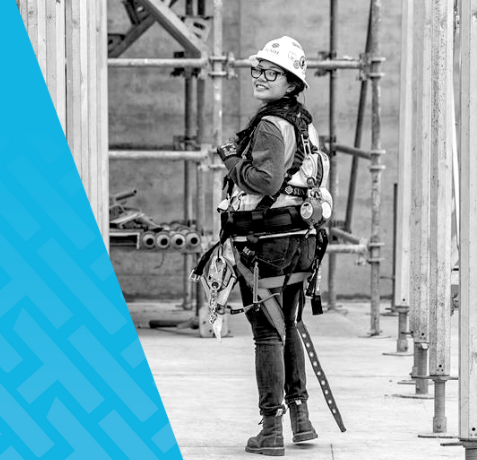Construction is historically a male-dominated field, but in recent decades, female participation has been on the rise. There is a growing recognition that diversity and inclusion are crucial to the success and growth of any organization—construction is no exception. More and more women are leading successful careers in the construction industry, and highlighting their efforts is essential to improving gender diversity.
To celebrate Women in Construction Week, we spoke with three construction leaders to hear their perspectives on the current state of women in construction and how we can empower more women in the industry.
- Reese Fortin is a District Health, Safety & Environmental (HS&E) Manager at Sundt Construction. Since entering the construction industry in 2007, she has managed dozens of safety professionals and hundreds of projects across the country. She is involved in each project from start to finish to ensure safety measures and performance are best-in-class.
- Chelsea Correia Lindberg is a Safety Operations Manager at Shawmut Design and Construction. She leads safety trainings, implements enterprise-wide programs, and partners with the entire safety team to ensure the successful execution of safety programs and initiatives, with 11 years of construction experience to boot.
- Michelle Gray is a National EHS Leader at DPR Construction who uses her knowledge and passion for safety to help protect all people and projects. She ensures environmental health and safety integrates into all aspects of work and fosters DPR’s safety values.
How Does Gender Diversity in Construction Today Compare to 5 Years Ago?
“Although we are moons away from gender diversity, we are heading in a great direction,” stated Chelsea. Women currently make up 10.9 percent of the U.S. construction workforce, according to the National Association of Women in Construction—a number that is slowly but steadily increasing.
Though minimal, the rise is evident across projects and teams. “I have witnessed firsthand the increase in gender diversity across job sites and industry events such as conferences. Years ago, there were many times where I was the solo female, but I’m pleased to look around these days and find myself in more diverse company,” explained Reese.
Michelle has seen similar improvements throughout her 20 years in the industry. Beyond just more women pursuing careers in construction, she has noticed another change. “The bigger shift in the last five years is that there is less of a stigma for those women wanting to go into construction or engineering and more acceptance that they can do it just as well if not better than their male colleagues.” She finds the younger generation is especially accepting of women in construction, which offers hope for the future in improving conscious and unconscious biases.
What Initiatives Do You See Making a Real Impact on Gender Diversity in the Industry?
Having open and honest conversations about gender diversity in construction is just step one. Next, companies must take action to set up programs and initiatives that lead to real change.
For instance, the Diversity, Equity, and Inclusion Committee at Sundt Construction is responsible for several initiatives that make a real impact on gender diversity, according to Reese. “My favorite example is how our committee came up with an initiative to get more ladies into our leadership programs by casting a wider net in the program’s application process.”
Michelle pointed to DPR’s program with local high school STEM programs as an impactful gender diversity initiative. “We are able to introduce young women to science and engineering in a practical way and show them that it is a career opportunity that can be fulfilling both professionally and personally.” However, she noted that there is still work to be done when it comes to promoting the trades as a suitable career path for women. “How do we show women that doing manual labor and getting dirty building great things can be an acceptable career path?”
Chelsea highlighted the importance of younger women witnessing women in leadership roles. “Seeing this allows women at any stage in their careers to see opportunities for growth.” Smaller initiatives like showcasing accomplishments and shifting language are equally important. “A foreman is now labeled a foreperson to be more inclusive to women,” explained Chelsea.
How Can We Ensure the Conversation Around Women in Construction Considers the Nuances of Underrepresented (Minority) Women?
The conversation on women in construction is often broad and fails to hone in on the unique challenges of the many intersections of female-identify. As a result, the diverse perspectives and needs of LGTBQ+, Asian, Latina, and black women can be overlooked which reinforces existing barriers and halts the success of gender-based initiatives.
To promote construction that is inclusive of all backgrounds, Reese suggests employers participate in the Associated General Contractors of America (AGC) Culture of Care program. “[Participation in such a program ensures] that every employee—from the CEO to the laborer— has the opportunity to feel valued, respected, and heard. Everyone must play a part in building a culture that is diverse, safe, welcoming, and inclusive by taking action to ensure that unwelcome, offensive, discriminatory, or harassing language or behavior is not tolerated in the workplace.”
Michelle understands that our differences are truly our greatest strengths. “The things that make us the same are the things that bond us together, and the things that make us different should be seen as what makes us distinct and better. It takes work and a willingness to see the human that is at the core—the person who bleeds, cries, hopes, and dreams of a better world.”
Is the Industry Considering the Different Needs of Women In the Field Versus In the Office or Management Roles?
Getting women into the construction industry is the initial barrier. Another one can appear between the women who work in the field and those who work in the office. The needs of each group vary significantly, and unfortunately, those on site are sometimes ‘out of sight, out of mind.’ Perceptive construction companies are noticing this disparity and making the necessary changes to lift up women in all roles.
For example, Reese described that Sundt Construction provides on-site women with appropriately-sized personal protective equipment (PPE) and separate restrooms. Both office and field personnel have flexible time off and can work from home when needed. Chelsea also remarked on the importance of acknowledging the equipment needs of women in the field.
In addition to providing physical items, Michelle acknowledged the significance of social and mental support. “We need to be more deliberate in promoting women in the field. We have many great leaders just waiting for the opportunity to lead, but because they have not been asked, they are overlooked. A stereotype for women is that we do not self-promote enough, so we need to change that and promote the women we work with, knowing that they may not do so themselves.”
What Conditions or Opportunities Have Helped You Thrive as a Leader in Construction?
While women leaders in construction possess personal skills that enable their success, many can attribute their achievements to significant events, supportive mentors, or positive company cultures.
Michelle’s helpful co-workers support her mantra to approach everything with curiosity. “[People] are usually so open and willing to share what they know—about construction and about themselves. It helps build the relationship, and I have not found anyone who said ‘go pound sand’ when I have shown up ready to be educated.”
Reese points to the industry events she’s attended as well as the culture of her current company as contributions to her success. “I’ve had the opportunity to attend a wealth of women’s industry conferences (WIC, NAWIC, ENR Groundbreaking Women, etc.). I’ve also attended numerous industry conferences that have contributed to my leadership skills and presence. However, the ability to work from home and take time off when needed without excess pressure or negative repercussions has been most helpful in allowing me to thrive as a leader.”
Chelsea has similar feelings about the importance of a company culture that supports working moms. “I have advocates and mentors that understand me as a working mother of young children. My effort spent driving change in my industry isn’t overlooked when I need to take a sick day for my toddler or have different hours due to childcare schedules.”
—
Although achieving gender diversity in the construction industry is still a work in progress, the future looks promising. Women are entering the field now more than ever, and various initiatives are being implemented to support their growth and development. Companies that recognize and support the unique needs of women, including minority women, are positioned for success.
A huge thank you to these leaders for sharing their perspectives and strategies. Be sure to connect with Reese Fortin, Michelle Gray and Chelsea Lindberg on LinkedIn to continue the conversation.





